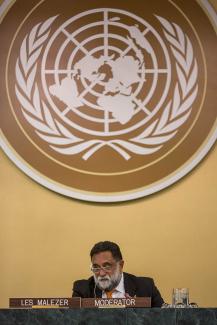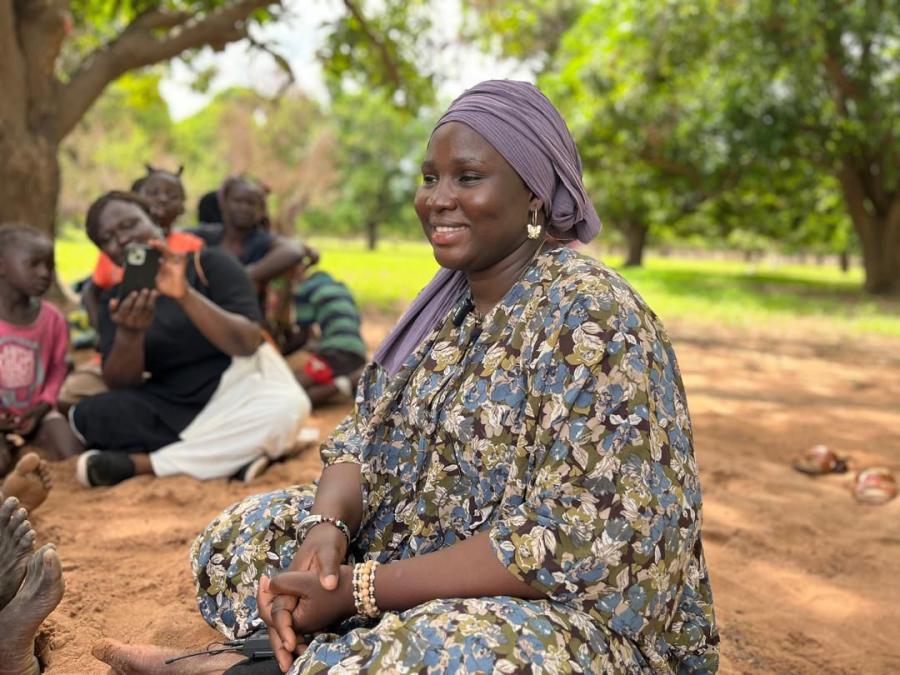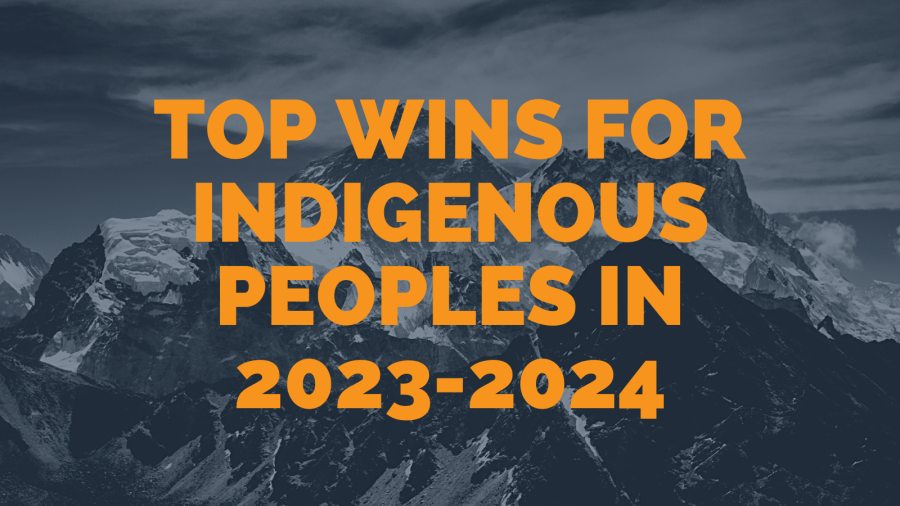
September 22, 2014 marked an important day for Indigenous communities everywhere. It was the first day of a two-day high level meeting of the General Assembly at the United Nations in New York City, doubling as the first World Conference on Indigenous Peoples. Throughout the day, over 1,000 Indigenous delegates gathered with government and UN officials, national human rights institutions, and various heads of state to discuss the best methods to approach and solve issues pressing Indigenous Peoples. The purpose of the meeting was to approve the conference’s Outcome Document, which would serve to renew and establish the international community’s commitment to addressing Indigenous rights. The following are excerpts of interviews with Indigenous delegates at the meeting.
Les Malezer (Gabi Gabi, Australia), Indigenous advisor to the president of the UN General Assembly:
"Indigenous Peoples started to organize very early once the General Assembly made a resolution that there would be a World Conference on Indigenous Peoples. In January 2013 we had a meeting of key leadership from around the world to decide how we would approach this world conference. At that time our big concern was that with this being a States-only process, there would be damage done to the Declaration on the Rights of Indigenous Peoples. So we tried to be proactive to say, ‘what can we do to get positive results?’ There were two key parts: one is that we tried to get the UN General Assembly to appoint a facilitator to work with the State-based facilitator for the world conference; we wanted two persons for this. The second point was that we try to do the first draft of a resolution to be adopted by the General Assembly, which would be called the Outcome Document. My role came in because negotiations with the General Assembly to get an Indigenous facilitator were not going well. The final agreement made earlier in 2014 was that there would be a team made up of the president of the General Assembly and four advisors, two of whom would be Indigenous people and two from member states. I was nominated, along with Mirna Cunningham from Nicaragua, by Indigenous people around the the world through the coordinating group to hold that position. The president accepted our nominations and so we were appointed as advisors.
High Level Plenary Meeting vs.World Conference
When the General Assembly passed a resolution for a world conference, we started to look into how this all works. Most people would think a world conference is an open event for all people to come and for expert presentations to be made. However, this was a meeting of the General Assembly, so it’s called a high level plenary meeting. The words “high level” mean that it involves leaders from countries rather than the staff at the consulates. As we investigated further, we found that this was a States-only process. When there have been previous world conferences, consulates start meeting three months beforehand and drafting the resolution, or the Outcome Document. That’s pretty much done out of sight, and then when the conference happens it’s voted on and adopted by all the member states. We wanted a different process, where Indigenous Peoples were in negotiation with the UN to develop the resolution and outcome document. We began last year in June with a meeting in Alta, Norway of over 400 Indigenous people from around the world, and during that meeting we drafted, presented, and adopted a document, which we called the Alta Outcome Document. Then we took it to meetings at the UN to say we wanted this to be the basis of the document adopted by the UN General Assembly. Fortunately the Alta Outcome Document was adopted as a UN Document; they registered it with an official number in the UN system, which means it is in the permanent record now. When negotiations began in late June for the final resolution at the conference, we used the Alta Document as the basis of the first draft; it is reflected very strongly in the resolution adopted by the General Assembly. It was a very successful process and a credit to the organization of Indigenous leadership.
The Consultation Process
I’m extremely proud of the consultation process: we’ve broken through a glass ceiling here by being directly involved at the General Assembly level face-to-face with member states to draft this outcome document. We can never go back now that we’ve amply demonstrated that we can effectively participate, that we’re not ignorant, we’re not militant, we’re not antagonistic and so on, that we can work well in that process. I was personally disappointed that the final version of the document was a States-only process. Mirna Cunningham and myself, as Indigenous advisors to the president, were able to participate in that process, and we made comments to ensure that mistakes were not being made that would affect our rights. I’m disappointed because in that final stage States continued to draft the text of the outcome document, and I felt that a lot of that discussion and drafting could have been done with Indigenous Peoples in the room. But we did do most of the drafting with Indigenous Peoples. I recommend that more effort be made in terms of not separating out the consultations and involvement of Indigenous peoples from the Statesonly process to ensure that it lives up to the motto, ‘Nothing about us without us.’
The Meaning of the Outcome Document for Indigenous Peoples
The outcome document is drafted. There are 40 paragraphs, and probably 35 of those are actions or operative paragraphs. All of them that talk about the UN or member states doing something internationally involve words like ‘in consultation with Indigenous peoples,’ or ‘with involvement of Indigenous peoples.’ Every action is meant to be an action; it’s a commitment by the member states but it’s an action involving Indigenous Peoples in whatever they do. There are some key statements; for example, in Paragraph 1 it says the United Nations has a continuing role to promote and protect the rights of Indigenous Peoples. It basically affirms that these are not solely domestic issues, that they do have international exposure and [factor into] international decision-making. And that’s very good for Indigenous Peoples when negotiating with member states. Paragraph 3 talks about Free, Prior and Informed Consent (FPIC), saying that for this document, FPIC by Indigenous Peoples is required in the actions being taken. In the followup of the outcome document, Indigenous Peoples around the world should be planning how to engage with their State or with the UN on every one of these paragraphs because it’s open to their full involvement.
Canada Rejects Free, Prior and Informed Consent
Canada was the standout objector to Free, Prior and Informed Consent in the document. That was not a surprise to most people, because Canada has made its political views on this known as far back as 2007. Despite the fact that they said they support the Declaration on the Rights of Indigenous Peoples, if they don’t support the right of FPIC they don’t understand or accept self-determination. You can’t reject Free, Prior and Informed Consent and say that you support the Declaration. It’s fortunate that Canada was the only State that really objected to this because it’s really a problem that Canada has to resolve for itself.
One of the important parts of the outcome document is that we want to assert that when it comes to a process to adjudicate lands, territories, and resources of Indigenous Peoples, the right of FPIC should be respected. Some member states had problems with the use of FPIC in that particular paragraph, so some adjustments were made to try and get around those concerns. But I just think that is niggling, because it is clearly established in the outcome document that the principle of FPIC applies throughout all paragraphs in the document.
The Drafting Process
There were some paragraphs that did get dropped. The problem was getting States to agree on wording or commitment to the action, and if we couldn’t get that agreement they would drop out. I would argue that we’re better off having fewer actions if we want to see them implemented. One of the last paragraphs to be dropped was about militarization, calling for those countries where military activities occur to consult with Indigenous Peoples over their concerns. It was a diplomatic approach to simply open up discussion with the Indigenous Peoples. The wording went around and around until the only wording that could be agreed upon was just a reiteration of what’s in the Declaration. We did not want the Declaration just to be reiterated in this document, otherwise it makes this outcome document an interpretive document. The recommendation to take that paragraph out was from Indigenous Peoples because it didn’t provide any particular action for the member states.
Adoption of the Outcome Document
I’m extremely pleased that the outcome document was adopted by consensus. There was no vote, so there was no real call from the floor to explain or qualify it. It’s an excellent outcome. A number of States were not present at the time; only a few of the African countries were in the room. A resolution adopted by consensus doesn’t matter if there’s a quorum or that everyone was in the room—the strength and the impact of the resolution is the same. The conference was well attended by member states with Indigenous populations in their territories, and well attended of course by Indigenous Peoples’ delegations. The General Assembly room was well represented by everyone on the day that the document was adopted. In terms of the consultation procedures, member states were reluctant to attend the initial consultations. We only had a few of them in the room, and a lot of them didn’t speak up. Not until the final stages would we have 60–80 States involved with speaking and taking the floor. It’s a pity that we didn’t get that kind of attendance when Indigenous Peoples were in the room.
Doors Are Open; Indigenous Peoples Now Have to Walk Through
At the conference, Indigenous delegates were all feeling very positive about what will happen after this process. The outcome document was kept as concise as it could be. We wanted it to be action-oriented. The smaller the document, the more likely the actions would be taken up and pursued, because it’s fewer things to focus on. Those 40 paragraphs are very specific in terms of the subject matter. It’s going to be very easy for people to look at particular paragraphs and say, ‘let’s go about implementing that,’ and ‘how are we going to do that.’ The other thing is that we deliberately incorporated paragraphs for UN procedures for promoting particular Indigenous Peoples’ rights, meaning every time there’s a forum on Indigenous Peoples’ issues these paragraphs will be raised for discussion.
There are requirements at the national level in the document. For example, the creation of national action plans for the member states to report on the situation of Indigenous Peoples when they’re reporting to treaty bodies or the Universal Periodic Review Process. Also, the UN will revise its mechanisms and add to its structure overview and implementation of the rights of Indigenous Peoples. The final key is the followup: there are paragraphs that call for reports to the General Assembly by the secretary general about what has been achieved, and the secretary general is to provide further recommendations on how to implement the outcome document. That’s about as watertight as we can get it.
The document is written in such a way that when it says ‘we commit’ to doing something, the member states are making personal commitments to action. Because this document was adopted by consensus it applies to all member states with Indigenous populations. It’s a clear commitment. However, like the Declaration, as a resolution of the General Assembly it isn’t a legally binding instrument. That can only be created through another process where member states individually sign a document saying they will enforce these things into law. Some states make an issue of this, so good faith comes into the process here—member states, in representing the peoples of the world, going to the UN and making resolutions, are required by the charter to treat these resolutions in good faith. The fact is that this is as strong as you can get it. It’s even stronger than action plans that we had under the First and Second International Decades of the World’s Indigenous People. I think that if Indigenous Peoples wanted to get to the highest level of getting commitments for member states to do things, we’ve reached it. This is the highest level.
The outcome document is a good result and provides opportunities. But now that the key doors are open, it has to be Indigenous Peoples that walk through those doors. We can’t wait for member states to take the initiative, although some of them will. Indigenous Peoples that haven’t been able to get into the room now have the door open. But they’ve still got to walk into the room, they’ve still got to put in the effort and the organization and engage through this process in order to get the results."
Listen to these interviews in their entirety and more at soundcloud.com/culturalsurvival.
To read the WCIP Outcome Document, visit: goo.gl/slPnlw.



